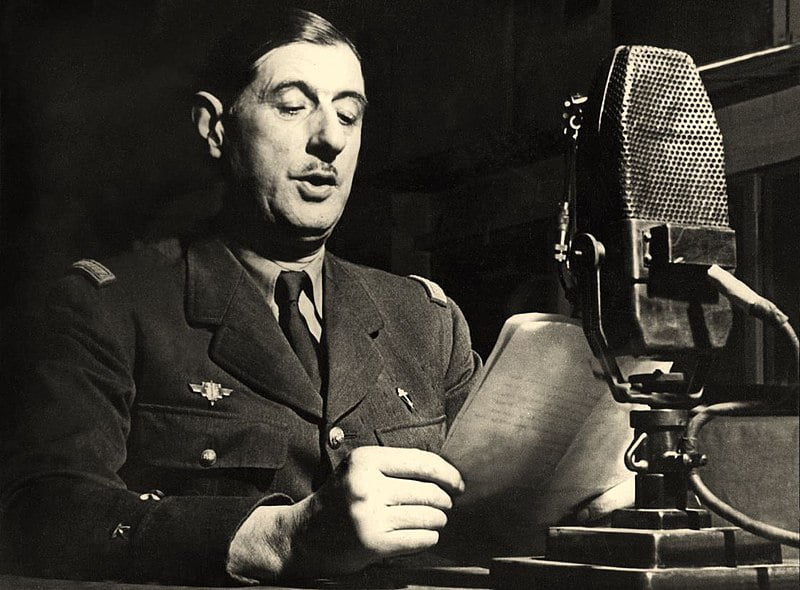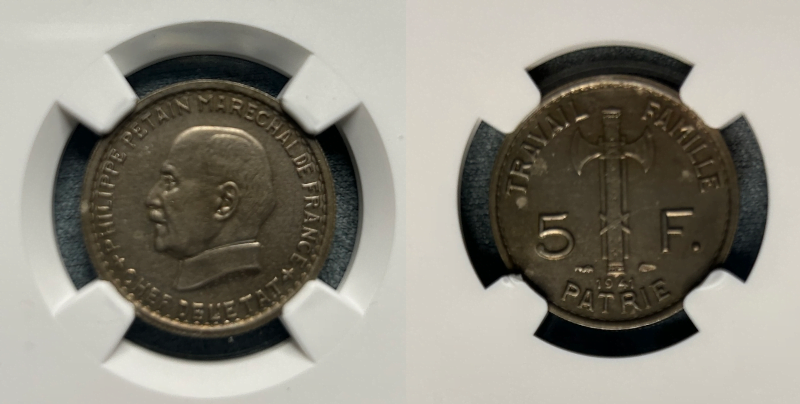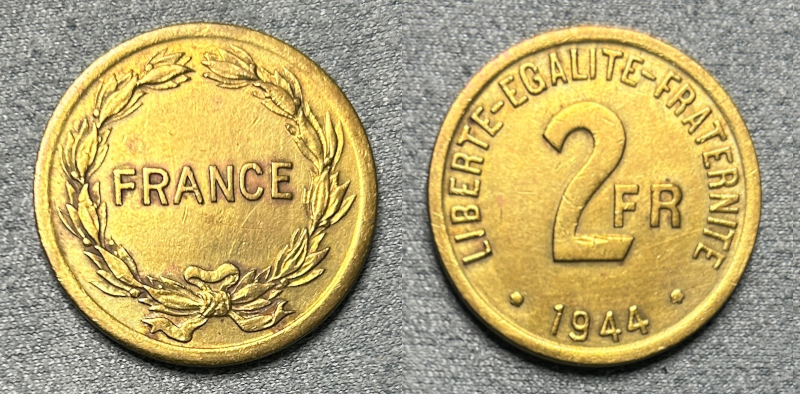No, this coin isn’t much to look at. Looking like something that could have passed for a final project in high school metal shop, this coin has less detail than a Chuck E. Cheese token. Indeed, it wasn’t very popular when it came out and it’s safe to say that its minimalistic design hasn’t won many fans in the years since.
Perhaps no one hated this coin more than Charles De Gaulle.
A French brigadier general and junior cabinet official, De Gaulle had escaped to London in 1940 with his country on the verge of a capitulation so sudden and complete that it spawned countless jokes and tropes that persist to this day. Denouncing the new French regime based in Vichy as an illegal German puppet state, De Gaulle formed Free France, a government-in-exile, with the intention of continuing the French war effort against the Nazis. A shrewd man, De Gaulle hoped to be seen as the head of the French Resistance – and become the natural leader of France once it was liberated from the Germans.
De Gaulle was not the only one jockeying to be recognized as leader-in-exile. President Franklin D. Roosevelt so disliked and distrusted him that he tried to make deals with General Henri Giraud and Admiral François Darlan to supplant De Gaulle. FDR even went so far as to cable U.K. Prime Minister Winston Churchill in 1943 to suggest that they occupy France and send De Gaulle to a place where he’d cause the least trouble, like Madagascar.

Historians differ as to how serious the Allies were. In When Roosevelt Planned to Govern France, Charles L. Robertson writes that FDR was very serious, but lacked support from Churchill, who also had a difficult relationship with De Gaulle, but believed he was the only French leader with enough support to lead the country after its liberation. However, Jean-Louis Cremieux-Brilhac argues in La France Libre: de l’Appel du 18 Juin a la Liberation, that the Allies had long ruled-out any sort of occupation of France.
But the very notion of a potential U.S.-led administration of France played into De Gaulle’s hands, and set the tone for decades of contentious relations between the two countries. America’s decision to mint millions of temporary Francs to be used by its liberating soldiers only added fuel to the fire.
The coins were minted in Philadelphia using brass from spent shell casings. The simple “France” on the obverse was that way out of necessity. Neither the Free French nor the Allies were interested in continuity with the Vichy regime, so printing “État Français” was never going to happen. Meanwhile, despite once expressing support for military administration, FDR believed that the U.S. had no right to dictate what kind of government France should choose, so printing “République française” on the coin was out.
That’s not to say the coin didn’t tip its hand at all. The reverse bore the traditional “Liberté, Egalité, Fraternité” slogan that dates back to the French Revolution and had been officially replaced by the more conservative and German-oriented “Travail, Famille, Patrie” slogan of the Vichy regime. The future of France may have been uncertain, but it was clear that Vichy France was dead. In fact, within three months after Germany surrendered to end the war (at the signing ceremony, Wehrmacht Chief of Staff Wilhelm Keitel reportedly expressed shock at seeing France treated as a victor) Vichy President Philippe Petain would be convicted of treason and sentenced to death before De Gaulle commuted the sentence.

De Gaulle may have shown mercy to his one time mentor – but he was not in a forgiving mood when he saw the U.S.-designed coins and paper money that were now legal tender in France. Officially, the currency’s main purpose was to give American soldiers stationed in France spending cash that could be redeemed as long as the Allies remained in control – regardless of what type of government and monetary system De Gaulle and his cohorts instituted. Denouncing the scrip money as “counterfeit,” De Gaulle interpreted the move as a violation of France’s sovereignty. The currency was withdrawn within a couple of months after it was introduced, but not before American soldiers were able to spread the 2 Franc coin around the south of France and in the French colony of Algeria.
Despite the unpopularity of the coin, as well as the sparse design, there are some noted similarities between the Philadelphia coin and its eventual successor, the new Franc. For instance both coins have a large, prominent number 2 on the reverse with the “Liberté, Egalité, Fraternité” slogan surrounding it in an arch-like formation. Perhaps fittingly (or ironically – depending on your point of view), the same reverse on the new Franc was used for a special 2 Franc coin issued in 1993 commemorating the 50th anniversary of the death of a famous French Resistance fighter. Perhaps it was for the best that De Gaulle had been dead for 23 years when that coin came out and never got to see it.

